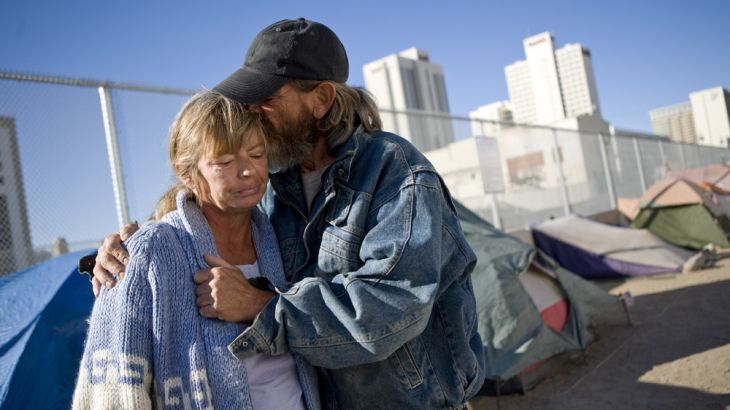
Lost and Found
About 700,000 Americans are homeless and the number of mentally ill people living on the streets is growing.
Filmmaker: Peggy Holter
According to the US’ substance abuse and mental health services sdministration “as many as 700,000 Americans are homeless on any given night. An estimated 20 to 25 per cent of these people have a serious mental illness”.
The number of people who are homeless in the US has always been a stunning statistic that seems to run counter to the promise of the American Dream. In the past two years, compounded by the deep recession, it is a statistic that has only gotten substantially worse.
There has long been a public policy debate about whether it is homelessness that leads many of those who are mentally ill to wind up on the street or if because they are already an at-risk population and their mental illness grows more severe by the difficult reality of living on the street with no support, no family care and few viable solutions.
A large and growing homeless population is evident in every major city in the US. In Washington, DC it is seen as especially remarkable because so much of it is visible from the halls of power where government entities are meant to find solutions to these issues. Instead the nation’s capital has one of the largest homeless populations – about 40,000 people.
Among that number there is a seemingly equally intractable issue, the mentally ill homeless. For the past 30 years this number has grown substantially as the support services provided to them have been eroded. It is now believed that the percentage of those among the homeless who are mentally ill is close to 40 per cent across the country.
During the 1980s, the indigent mentally ill would be institutionalised by court order until they were successfully treated or other resources could be found to support them. When that policy ended it led to a surge in the number of mentally ill homeless and that has continued to grow in the following decades.
Vagrancy charges were frequently used to get many of the homeless, including the mentally ill, off the streets. But this led only to short-term housing solutions with no connection to long-term mental health care. Further, it led to petty crime cases clogging court dockets.
Some alternative health care solutions are available, including short-term stints under a doctor’s care and prescriptions for medication to treat many of the disorders that are most common among this population, such as schizophrenia. But being homeless and without any long-term financial support often means that regular access to prescriptions and maintaining a schedule with a therapist is almost impossible.
Over the years countless efforts have been made to address this issue at governmental and charity levels. But there is a conflict between those who believe that providing housing should be a primary concern because mental illness exists regardless of whether or not somebody has a home and those who believe that only when the reasons behind homelessness – be it mental illness, substance abuse or economic need – are resolved, can stable housing be provided by the government.
It is in this swirl of debate that we found David and Nellie – each with their own troubled journey and issues. Their cases are different, as are the solutions outlined in this film.
There are a number of initiatives that are being pursued in Washington. One is a court-based programme that is devoted strictly to providing a non-incarceration route for the mentally ill who have been arrested for petty crimes.
Another solution that is outlined in this film is part of a non-profit organisation called Pathways to Housing. It was founded in the early 1990s by Sam Tsemberis and now operates in a number of cities across the US. Its goal is to provide stable and ultimately affordable housing to those in greatest need among the homeless, whether they are mentally ill, recovering from substance abuse or simply navigating the difficult transition back from economic ruin.